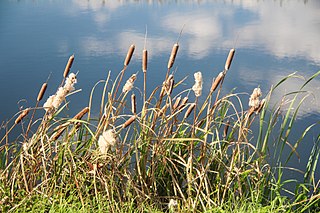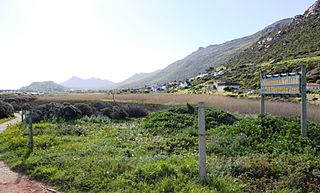
Typha is a genus of about 30 species of monocotyledonous flowering plants in the family Typhaceae. These plants have a variety of common names, in British English as bulrush or reedmace, in American English as reed, cattail,or punks, in Australia as cumbungi or bulrush, in Canada as bulrush or cattail, and in New Zealand as raupo. Other taxa of plants may be known as bulrush, including some sedges in Scirpus and related genera.

Root vegetables are underground plant parts eaten by humans as food. Although botany distinguishes true roots from non-roots, the term "root vegetable" is applied to all these types in agricultural and culinary usage.

Reed is a common name for several tall, grass-like plants of wetlands.

A straw hat is a wide-brimmed hat woven out of straw or straw-like synthetic materials. Straw hats are a type of sun hat designed to shade the head and face from direct sunlight, but are also used in fashion as a decorative element or a uniform.

A reedbed or reed bed is a natural habitat found in floodplains, waterlogged depressions and estuaries. Reedbeds are part of a succession from young reeds colonising open water or wet ground through a gradation of increasingly dry ground. As reedbeds age, they build up a considerable litter layer that eventually rises above the water level and that ultimately provides opportunities for shrubland or woodland invasion.

Schoenoplectus is a genus of plants in the sedges with a cosmopolitan distribution. Note that the name bulrush is also applied to species in the unrelated genus Typha as well as to other sedges. The genus Schoenoplectus was formerly considered part of Scirpus, but recent phylogenetic data shows that they are not closely related.

Typha latifolia is a perennial herbaceous plant in the genus Typha. It is found as a native plant species in North and South America, Eurasia, and Africa.
Kidd's Beach is a small coastal resort town in the Eastern Cape, South Africa situated on the Mkhanzi River about 28 kilometres from East London, South Africa. The name "Mkhanzi" is derived from the Xhosa word "umkhanzi", which means "bulrush", or Typha capensis. Kidd's Beach was named after Charles Kidd, who was the mayor of nearby King William's Town in the 1860s.

Street Heath is a 12.5 hectare biological Site of Special Scientific Interest 4 km west of Glastonbury in Somerset, notified in 1966. It next to the Glastonbury Canal and Ham Wall nature reserve. Street Heath has itself been designated as a Local Nature Reserve.

Typha angustifolia L. is a perennial herbaceous plant of genus Typha. This cattail is an "obligate wetland" species that is commonly found in the northern hemisphere in brackish locations.

Bolboschoenus fluviatilis, the river bulrush, is a species of flowering plant in the sedge family, Cyperaceae. Its range includes Australia, New Zealand, New Caledonia, Canada, the United States, and northeastern Mexico. B. fluviatilis and its fruits are important as food sources for waterfowl such as geese, ducks, bitterns, and swans. It also provides cover and nesting sites for these and other species of birds, as well as small mammals. Like other Bolboschoenus species, B. fluviatilis has strong tubers and rhizomes which help to stabilize intertidal habitats by preventing erosion.

Calamotropha is a genus of moths of the family Crambidae.

The bulrush wainscot is a moth of the family Noctuidae. It is found from Ireland and Portugal to southern Fennoscandia, east to western Siberia, the Altai Mountains, Yakutia, Turkey, the Caucasus, Lebanon, Egypt, Arabia, Iraq, Iran, Afghanistan and Central Asia.

Decoy Pit, Pools and Woods is a 17.7-hectare (44-acre) biological Site of Special Scientific Interest south of Aldermaston in Berkshire. An area of 8 hectares is a nature reserve called Decoy Heath, which is managed by the Berkshire, Buckinghamshire and Oxfordshire Wildlife Trust.

Lower Silvermine Wetlands is a nature reserve on the Cape Peninsula, in Cape Town, South Africa.

Typha minima, common name dwarf bulrush or miniature cattail or least bulrush, is a perennial herbaceous plant belonging to the Typhaceae family.
Calamotropha aureliellus is a species of moth in the family Crambidae. It is found in France, Switzerland, Austria, Italy, Germany, Poland, the Czech Republic, Slovakia, Hungary, Romania, Bulgaria, the Republic of Macedonia, Greece, the Russian Far East and Japan.

Typha orientalis, commonly known as bulrush, cumbungi, or raupō, is a perennial herbaceous plant in the genus Typha. It is native to Australia, New Zealand, Malaysia, Indonesia, Japan, Korea, Mongolia, Myanmar, Philippines, China and the Russian Far East.

Bulrush is a vernacular name for several large wetland grass-like plants
Common names for "rush" are usually related to a particular genus from a botanical family, for example:

















